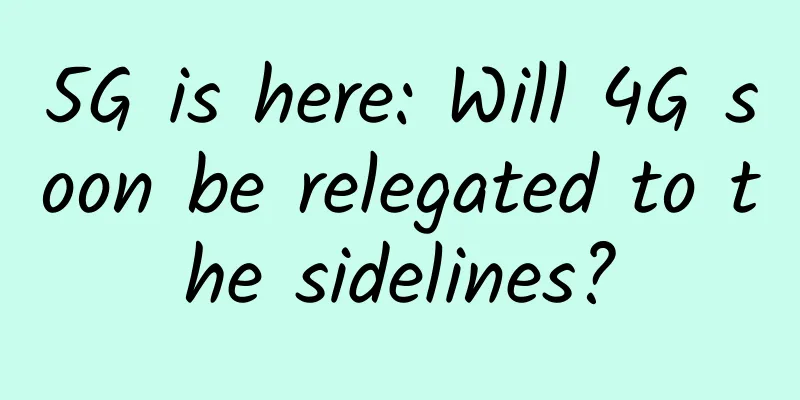5G is here: Will 4G soon be relegated to the sidelines?

|
Will 4G, which once brought prosperity to the mobile Internet and truly changed the lives of many people, soon be relegated to the cold palace? The pursuit of the best experience has been the driving force behind the continuous development of the communications industry over the past few decades. Compared with 4G, the upcoming 5G can bring a 10-fold improvement in experience, easily meeting the network needs of ordinary consumers for high-bandwidth services such as virtual reality and ultra-high-definition video, further driving consumption upgrades; at the same time, it will also have a profound impact on all walks of life, meet the application needs of automatic manufacturing, drones, and Internet of Vehicles, and support the innovation and development of the whole society. So after the arrival of 5G, do we still need 4G?
The marriage of 5G and vertical industries is a marathon, and it is necessary to start early The integration of communication technology and vertical industries requires action to be taken today, with continuous exploration and accumulation. In terms of business, 5G is designed to support a variety of applications and business models in various scenarios, such as enhanced mobile broadband, high reliability and low latency, and low power consumption and large connections, through technological innovation and new spectrum. However, the integrated development of 5G and vertical industries will be a long and arduous task, and we cannot wait. With the advent of the Internet of Things era and the continued rise in enthusiasm for digitalization in vertical industries, the window of opportunity has arrived. The active exploration in the 4G industry will lay a solid foundation for the prosperity of 5G. my country should take the lead in continuing to do a good job in industry innovation in the 4G industry, continue to strengthen the deep coverage of 4G networks and improve experience, continue to explore new ideas, new models and new services for the development of mobile Internet of Things, and drive the development of new integrated businesses such as smart meter reading, smart parking, safe cities, clean cities, shared bicycles, Internet of Vehicles, and industrial Internet. The correct approach to 5G deployment is to make up for shortcomings with strengths and weaknesses and to combine high and low The higher the frequency, the worse the penetration. China has allocated spectrum for 5G near 3.5GHz and 4.8GHz. Compared with 2G/3G/4G, 5G requires more sites and a longer construction cycle than before to build a continuous high-quality experience network. It is bound to not be achieved overnight. For a long time, the coverage area of 4G will still be larger than that of 5G. 4G networks can provide high-quality HD voice experience and better solve the user experience in deep coverage scenarios such as indoors. Continuously improving the 4G VoLTE experience is an important task before the maturity of 5G IP voice, and it can also accelerate the re-cultivation of 800MHz and 900MHz golden spectrum. On the other hand, for high-traffic areas such as shopping malls and buildings, the high penetration of 5G spectrum determines that the traditional outdoor site coverage indoor solution will be difficult to work. Deploying high-capacity digital indoor distribution indoors has become a key means generally recognized by the industry to solve 5G indoor coverage and capacity. High-quality low-frequency 4G network has always been an important supplementary solution for indoor coverage. In addition to serving as a full-service basic network for 5G, 4G can also collaborate with 5G to help 5G expand its capacity and coverage. From a deeper perspective, 5G networks are more dependent on fully cloud-based infrastructure, and operators are also going through a stage of vigorously building data centers. If operators have limited initial investment or the pace of cloud infrastructure construction cannot match the commercial needs of 5G, they can consider deploying 5G base stations in key areas first, and using the upgraded 4G core network to provide services for the 5G base stations. In this way, the user's mobile phone usually resides on the high-quality 4G network, and has a better experience in mobility and voice services. The 5G cell is activated only when a large amount of data needs to be transmitted. At this time, the mobile phone can enjoy 4G and 5G services at the same time, which is the so-called non-independent networking. This 4G and 5G collaborative networking method can reduce the initial investment cost of 5G, and ensure that users can get a better mobility experience before 5G forms continuous coverage. 4G has just entered middle age and can continue to shine for more than 10 years From a global perspective, 4G is expected to have a life cycle of 10 to 15 years. Looking back, every communication network's life cycle has gone through several stages: load, rapid penetration, stable development, and gradual withdrawal. In the past 10 years, my country has made great strides in mobile communication technology, building the world's largest 4G network, with more than 1.1 billion 4G users nationwide. The 4G network is mature and stable, with comprehensive and in-depth coverage, and can meet the needs of a considerable number of applications or services. From the perspective of making full use of existing network resources and ensuring the best user service experience, not all services need to run on 5G networks. Therefore, the continuous expansion of 4G capacity is considered to be the most cost-effective investment direction that can meet the needs of current mainstream services. 5G has not yet been truly commercialized, but some 5G technologies have been commercialized on 4G networks in advance; 4G networks have also benefited from the early introduction of 5G technologies, greatly improving network capacity and user experience, and shortening the gap between 4G and 5G - for example, through multi-antenna technologies such as 3D MIMO and 4T4R, the capacity of the existing network can be further increased by about 5 times, meeting the capacity requirements in the next few years, and can also evolve into a part of the 5G network. This is also the 4G network development technology concept generally accepted by the world's leading operators. So far, 3D MIMO has been deployed in tens of thousands. In short, even if 5G comes, 4G will not be eliminated. 4G networks will coexist with 5G networks for a long time in the future, bringing users the best experience; and for operators, doing a good job in the coordinated development of 4G and 5G will also play a role in promoting future business development. |
<<: How professionals can develop their latest data center skills
>>: When WiFi Master Key quietly takes away your password, do you really not mind?
Recommend
Huawei's first Intelligent Computing Conference was held in Beijing. Huawei released a new intelligent computing strategy to meet the 100 billion market
[51CTO.com original article] On December 21, 2018...
Let's talk about 3CC, which is very popular this year
The day before yesterday, I published an article ...
5G small base stations are about to take off!
On the one hand, the higher frequency band of 5G ...
Five ways edge computing drives digital business
Every industry has created a new normal: if your ...
Blockchain cross-domain security solution
1. Evolution of blockchain development Looking ba...
Security teams’ need for flow data drives NetSecOps collaboration
You’ve probably heard about the fact that network...
GTI releases 2.3GHz spectrum industry joint statement
As 5G accelerates globalization, it will unlock u...
Huawei releases next-generation smart product strategy and new +AI series products
[Shanghai, China, September 18, 2019] During HUAW...
NTT provides one-stop overall solution for international schools based on Cisco digital network architecture
The tide of digitalization has already affected e...
Compared with China Telecom and China Unicom, why is China Mobile's broadband so slow?
If you have been using China Telecom or China Uni...
How to choose an operation and maintenance monitoring platform that suits you? Zabbix, Prometheus, Grafana
As an operation and maintenance person, operation...
EasyVM: $3/month KVM-2GB/30GB/2TB/Dallas & New York, etc.
EasyVM is a foreign hosting company founded in 20...
Report: The number of Internet users in my country has reached 940 million, of which nearly 223 million are students, accounting for 23.7%
According to CCTV reports, the 46th "Statist...









